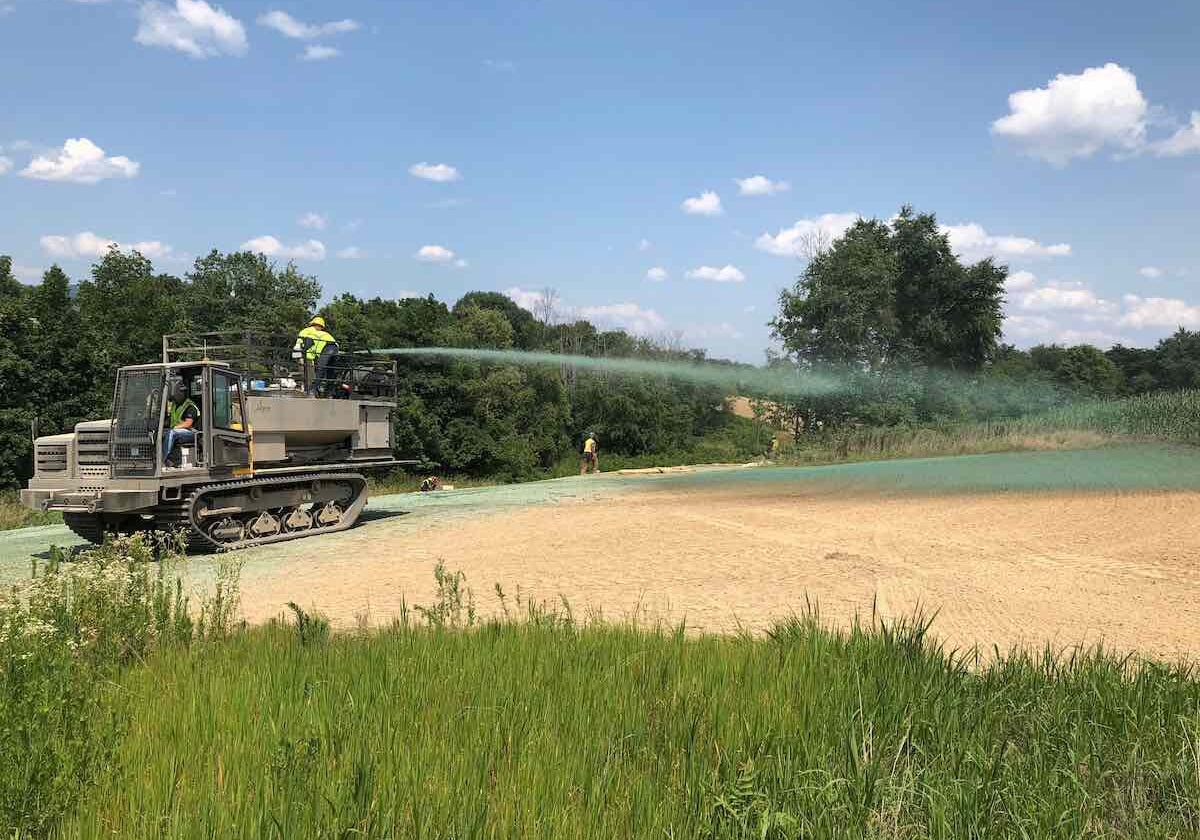Hydroseeding for Erosion Control on Slopes

Share this article!
Erosion can be a landscaper’s most annoying adversary. From large commercial projects like highway construction to smaller residential jobs, contractors of all kinds can run into issues with soil displacement caused by erosion.
Any time large amounts of earth are disrupted, there’s a potential for erosion, and this is particularly true on hillsides, slopes, and embankments where it’s easy for water to run down – and take the nutrient-rich topsoil with it. It’s not uncommon for this process to change the entire appearance of an area, or the fundamental lay of the land.
To address this, many landscape contractors and builders turn to both natural and artificial methods for erosion control on steep slopes.
Methods for Erosion Control on Slopes
There are several ways to prevent erosion and soil degradation during construction and landscaping. One commonly used method is erosion control socks, or sediment filter socks, which are long tubes of materials – usually organic material – that filter out debris but allow the water to flow through. These socks help keep the soil where it belongs, while allowing the water to continue on its natural drainage course.
In addition to erosion control socks, which can be used for areas where the land is fairly minimally disturbed, for steep slope erosion control methods, contractors may need to employ added or more complex approaches like:
Erosion Control Blankets
Erosion control blankets (ECBs) are mats made of woven, usually natural, fibers that are designed to be biodegradable and used to spread over areas that are prone to erosion. ECBs are especially useful for areas where bare soil has been exposed on a steep slope or hillside to establish vegetation initially. ECBs can hold seed, moisture, and fertilizer in place effectively, giving plants and grasses the opportunity to establish before the ECB naturally degrades into the environment.
Different materials can be used for ECBs, each lasting different periods of time depending on the type of soil stabilization necessary. Some ECBs last for a few months, where others can be used to support revegetation on steep slopes for as long as a year or more.
Building Terraces
Terrace building has been used to control erosion on steep slopes and hillsides for centuries. Generally the most involved method, terrace building is also often the most effective. By building a terrace, or wall to support an embankment, contractors can ensure soil stays where it belongs to control water runoff and erosion.
Terraces can be built from a variety of materials, ranging from natural materials to concrete blocks or stone, depending on the project’s needs. Terraces can be made from natural materials to create a type of living wall that helps provide a long term solution to keep dirt from washing away on a slope.
Planting Vegetation
Another way to keep dirt from washing away on a hillside is to plant native vegetation. Native plants are generally the best choice to retain moisture and stabilize the soil. Since native plant root systems are already adapted to the soil and conditions, you’re likely to not only have more success growing them initially, but they’ll be better positioned to provide effective soil stabilization on slopes for the long term as they grow and establish.
Hydroseeding vegetation is an effective, quick method to apply native seeds to a steep slope or hillside. Since hillsides can be notoriously difficult to hand seed or plant, hydroseeding takes the process and makes quick work of it by spraying a slurry of seeds, fertilizer, and water as far as 350 feet, depending on the hydroseeder. So no matter how steep or hard-to-reach your slope or embankment may be, a hydroseeder can evenly apply seed to help establish native plants that can help retain soil and prevent damaging erosion.
What Sort of Slopes Can You Hydroseed?
Hydroseeding moderate slopes is an effective and efficient choice for many large landscaping projects. However, the most effective erosion control solution will always depend on the specific landscape in question, and often, using a combination of methods can yield the best results for the environment.
Mild Slopes (less than 25%)
When the slope or hillside is gradual, mild, or barely noticeable, hydroseeding can be used to expect dependable, quick results. Mild slopes often require less attention, as runoff is more easily prevented and soil can generally be stabilized by hydroseeding alone.
Moderate Slopes (less than 33%)
Moderate slopes can also be effectively hydroseeded to prevent soil runoff, however the landscape must allow for heavy machinery access for this to be effective. For slopes and hillsides with a grade above 33%, hydroseeding can be used with success so long as the machine can access the site. Moderate slopes may be a case where a combination of erosion control methods, such as erosion control blankets or sediment socks and hydroseeding native vegetation should be used to best prevent erosion.
Steep Slopes (over 50%)
For steep slopes, sharp hillsides, and other hard-to-reach areas, hydroseeding may not be the most effective approach. Generally slopes with a grade above 50% won’t have as much success with hydraulically-applied products like hydroseeded mixes than grades below 50%, though again, this depends on the land itself and the composition of the existing soil.
To effectively control erosion on a steep hillside, a combination of methods like erosion control blankets, sediment socks, and planting should be used to ensure the most effective soil retention.
Choosing the Right Hydroseed Mix for Slopes
Learning how to control erosion on a slope is often a function of understanding the landscape itself, and the variety of methods available to prevent runoff. For example, some residential projects with mild slopes may be stabilized effectively with hydroseeding to create both an aesthetically pleasing result and comply with local and federal regulations surrounding construction runoff, pollution, and water quality.
Other projects, such as highways with steep embankments or larger ground disruption may require a more nuanced approach to combine erosion control methods for the most effective soil stabilization solution. Erosion control socks may need to be strategically placed at the onset of construction and erosion control blankets placed during landscaping to retain soil quality, and finally, hydroseeding may be used upon project completion to ensure the slope is properly stabilized for the long term.
Takeaway: Is Hydroseeding Good for Slopes?
Hydroseeding is generally a fast and effective method to stabilize slopes that have been disrupted by construction and landscaping projects. Native plants are especially effective at preventing runoff and stabilizing the soil, and hydroseeding can help establish that native vegetation using minimal resources and manpower.
Hydroseeding can also help contractors and landscapers adhere to regulations for land disrupting projects, to ensure that construction doesn’t pollute surrounding waterways and to help ensure soil is stabilized to prevent environmental issues.
